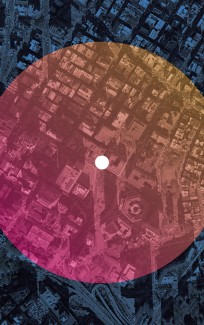7 questions to Carlo Ratti
Buildings in the future might not look too different – but they will behave differently, Carlo Ratti says when asked about his work and about buildings of the future. Carlo Ratti is a founding partner of Carlo Ratti Associati design practice in Turin, Italy and director of the MIT SENSEable City Lab. The Media Architecture Biennale 2014 features the world premiere of the lab’s ‘A Decade of Mapping a Senseable City.’

Carlo Ratti: “Not enough land for a building? Find a way to make it float off shore!” (Photo: Lars Krüger)
If you should point out just one of your pieces/works, which one would it be – and why?
I would point to one of our key projects, the Digital Water Pavilion, debuted in 2008 for the Zaragoza World Expo. The theme of the expo was “Water” so – continuing a long tradition of water in architecture – we created a building made from water. Computer-controlled valves make glistening walls composed of millions of tiny falling droplets, changing constantly to show dynamic text and images. Using sensors, the building could detect visitors approaching and make an entrance in the water curtain wall.
For me, the most exciting thing about this project was seeing how people react to an entirely novel spatial experience. Kids, especially, immediately understood that this is a playful, interactive space and started using it for games or trying to “outsmart” the sensing system.

Digital Water Pavilion, a project by Carlo Ratti Associati. (Credits: www.dwp.qaop.net. Photo: Ramak Fazal)
What characterizes your practice?
The design office, Carlo Ratti Associati, has a uniquely research-based approach that usually falls into three main categories. First, we push the boundaries of technology, with projects like an oven that MRI-scans your food or a dynamically floating pavilion using technology developed for submarines. Second, we create new energetic and collaborative processes that drive projects like The Cloud, a crowd-sourced icon for London’s skyline. Finally, we develop projects with a playful interactivity, like the Digital Water Pavilion, the Vertical Plotter, or the Makr Shakr ‘robotic bar tender.’
What are the biggest challenges that you work with and try to work your way around?
Each project brings with it a specific set of challenges, but in my experience those generally result in the best design responses. Not enough land for a building? Find a way to make it float off shore!
Do you see a distinction between media and dynamism in architecture?
‘Media’ as in ‘the media’ is all about the visual sense. Architects have been chasing after ‘dynamism’ for centuries – even starting in the Baroque period – but now we have new digital tools to achieve it in a more meaningful way. That is, a way that impacts your spatial experience, not just your visual impression. I’m not very interested in ‘media’ as architecture-scale screens, but at both CRA and the Senseable City Lab, we are working towards a new kind of ‘dynamism’ based on sensing and active architecture. An architecture that senses and responds…
What would be your advice to young people entering the field of media architecture?
The term ‘media architecture’ shouldn’t have much to do with either ‘media’ or ‘architecture.’ Figure out what it can mean.
How does your work process negotiate the serendipity that defines broader networked communities?
This is a difficult question – particularly for a professional ‘designer’ to answer. I believe networks and open platforms for creativity are changing the world. Linux was an example for software, but now Fab Labs, 3D printers and a whole host of developments are giving everyone in the world tools to design… The question is: will that kill the ‘architect’? I don’t think so. But open sourcing will certainly change the game, and change the role and the output of designers. Our book called Open Source Architecture, coming out this month (Einaudi, Italy; Thames & Hudson, UK) ends with the idea of a more plural designer, or what we call the ‘Choral Architect.’
What should we expect from the next generation of buildings – that is, how will they impact daily life?
Buildings in the future might not look too different, in the same way as the Roman city was not that different of the one we know today. I don’t expect dizzying cityscapes of signature Hadid-curves; however, buildings will behave differently. Instead of being designed, built and then just existing until they crumble, buildings will have a dynamic lifetime, responding to how people use them. Human habitation will not be about ‘living in’ your house so much as ‘living with’ it. People and architecture will be symbiotic – with a responsive built environment that not only improves efficiency but also people’s comfort and daily life… Ultimately this is the goal of all our work, whether at MIT or in the design office.



































